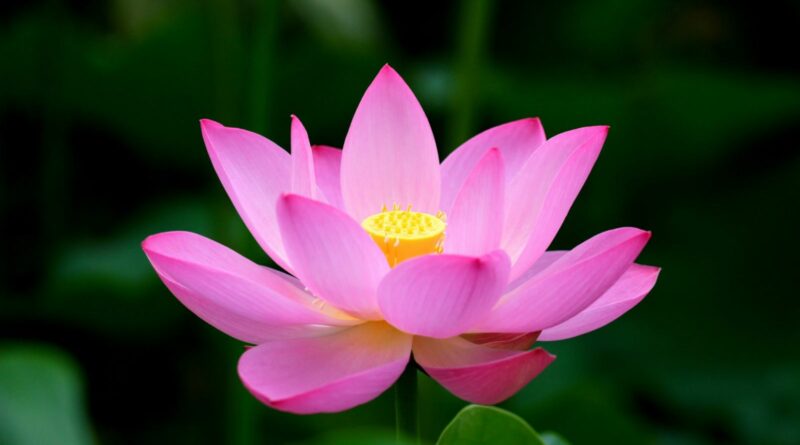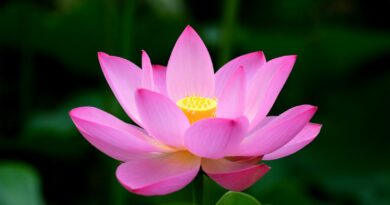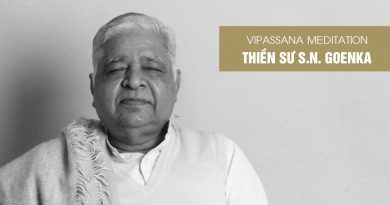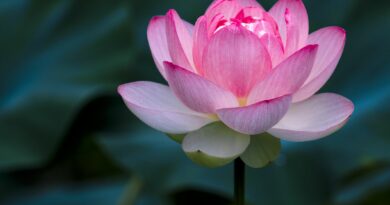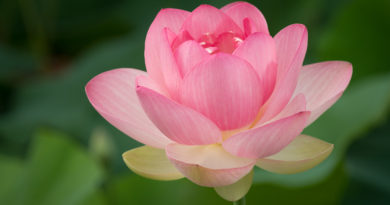Vipassana For The Betterment Of The Society
(Excerpts from opening talk delivered by Mr. S. N. Goenka at the International seminar “Vipassana: Its Relevance to the Present World” held at the Indian Institute of Technology, Delhi from 15-17 April 1994)
Dear Friends: Each morning, the light of the sun dispels the darkness of the night. It makes no difference which part of the world it is shining upon, or in which season or year; whether in the past, present or future, the darkness vanishes automatically with each sunrise. Similarly, the light of Vipassana dispels the darkness of ignorance and of misery regardless of the time or the place. All around the world today the darkness of suffering is painfully apparent. People everywhere are eager to find an answer to the misery in their lives. Thus it is no wonder that the light of Vipassana–the light of wisdom–has proven itself of such relevance to the modern world. When we generate vibrations of negativity–anger, hatred, ill-will, animosity, ego, etc.–the atmosphere around us becomes charged with these vibrations. This pollution, although invisible, causes so many problems in human society–tensions, stress, strain, conflicts. Misery, nothing but misery. Vipassana is the way out of this misery. It is a technique to purify the mind. In order to overcome the darkness of ignorance and negativity we must generate love, compassion and goodwill. In order to generate these wholesome qualities, we need to purify our minds. This was necessary in the past, it is necessary today, and it will always be necessary. Society is made up of individual human beings. To reform it, each member of society has to be reformed. Hence, the individual is the key. Human beings have a unique capacity to observe the reality within to develop true wisdom, true insight. The saints and sages of India and of other countries discovered a way to purify the mind. Every individual must practise this path of purification. If the individual can’t come out of misery, how can society come out of misery? Thus, man matters most. And when one talks of man, mind matters most. It is the mind which creates all these different types of pollution. As long as the mind remains impure, it will continue to generate unhealthy vibrations, making the entire atmosphere full of misery. And unless one starts observing the truth within at the experiential level, mere intellectual understanding will not help. Reading the scriptures or listening to discourses is good; they give us guidance and inspiration. But they can’t make us realize the truth about ourselves. For that we have to go deep within ourselves, and this is what Vipassana does, not merely at the intellectual or devotional level but at the actual, experiential level. The surface of the mind-a very small part of the mind, the intellect-always sees things outside and gives them importance. You might think that you are miserable because someone has insulted you or misbehaved; or maybe because the situation you are in is not to your liking. At the apparent level, this is true, but when you go deep within you will find that the entire cause of the misery lies inside. Similarly, the entire cause of happiness also lies inside, not outside. The actual truth lies deep within. For every unwholesome action, vocal or physical, the root is the mind. You cannot kill unless you generate anger, hatred, ill-will, or animosity. You can’t steal unless you generate greed. And you can’t commit sexual misconduct unless you generate passion. Before your action harms someone else, you have actually harmed yourself. When these impurities become strong, you take an action at the physical level. The moment you start generating negativity in the mind, the law of nature is such that you are punished here and now. You become miserable. It takes time for the laws of government to ensure that you are punished, but the law of nature does not wait. We don’t understand what is happening inside. When anger arises, we give all our attention to the outside object-the person, the situation–we try to rectify things outside. For example, if you ask a mother-in-law why there is so much misery in her family, she will say it is because of her daughter-in-law: “If she improves, there will be peace.” If you ask the daughter-in-law, she will say, “The old lady-if she improves a little, everything will be alright.” A father wants his son to improve; the son wants his father to improve. They do not consider the defects they have in themselves, the real cause of their misery. When one starts practising Vipassana and experiences the truth within oneself, the words of the Enlightened One become very clear:
“
Pubbe hanati attanam pacca hanati so pare.
”
–First one kills oneself and only then does one kill others. Only by first destroying the peace and harmony within oneself can one destroy the peace and harmony of others. Before one performs an unwholesome action, some impurity must arise in the mind. Whenever one generates such impurity, one makes oneself miserable. Suppose somebody wants to make you miserable by insulting you, and you accept that abuse and become miserable. The person might insult you only once, and then go away, but if you continue to repeat the same drama on the stage of your mind, what have you done? If you keep reminding yourself of the abuse, you keep generating anger. You are harming yourself. This process cannot be understood by mere discourses. One might be convinced that what is being said is quite reasonable, but the moment one goes out of the lecture hall it is all forgotten. Accepting things only at the devotional level–Buddha said so or Mahavira said so or Krishna said so or Jesus Christ said so or Prophet Mohammed said so; and I have great faith and devotion in their words–does not help. It is only one’s own wisdom, one’s own vijja at the level of vedana, one’s own experience, that can liberate one-nothing else. This is what was realized by the Enlightened One; by every enlightened one. We must understand what happens at the experiential level. When the six sense doors and their respective sense objects (salayatana) come in contact, something happens inside. For instance, one part of the mind (vinnana, consciousness) simply cognizes that a sound has come in contact with the ear. Now the second part of the mind (sanna, perception) recognizes the sound, perhaps as words of abuse, or as words of praise. It not only recognizes but also evaluates: the abuse is bad, or the praise is good. When one looks within, one finds that the moment a sound touches the ear sense door, there is a vibration, a neutral vibration. If the sanna (perception) says that it is bad, this vibration changes into an unpleasant physical sensations or vibration. If the sanna says, “Oh, this is a word of praise; ah, wonderful!”, then immediately this neutral vibration becomes very pleasant. These sensations comprise the third part of the mind: vedana. In India today the word vedana has only one meaning: misery, unhappiness, pain or sorrow. Twenty-five centuries ago vedana referred to any sensation–pleasant, unpleasant or neutral. The fourth part of the mind, the sankhara, reacts to the sensation. At the apparent level it looks as if we are reacting to something outside, such as praise or abuse. But we are actually reacting to a pleasant or unpleasant sensation. This sensation is the missing link of which we remain ignorant. If we do not realize this, then we cannot stop the process of reaction deep within ourselves. At the surface level of the mind we may understand intellectually that we should not react with craving or aversion. We may remind ourselves that both are to be avoided, and that we should be equanimous. In reality, however, only a small part of the mind is equanimous. We don’t know what is happening to the larger part of the mind, the so called “unconscious”. This part is always conscious, day and night, conscious of the sensations on the body. And day and night it is a prisoner of its own habit pattern. The deep habit pattern of the mind is to react. We have to rectify this problem at the depth, at the root of the mind. We may suppress our reactions at the surface level, but deep inside we keep on boiling with anger, aversion, animosity, craving and ego. At the intellectual level, we remain unaware of all these deep-rooted impurities. By experiencing the reality deep within, each individual has to develop his own enlightenment to be free of misery, and to enjoy real peace and harmony within. Each of us has to work to achieve this. For a long time I knew that Vipassana was a good technique, one which could help the individual to help society. But I wondered how it could be taught to the masses, because it is difficult for most people to come for a ten-day course. I was pleasantly surprised when I saw the rock edicts of Emperor Asoka. The technique of Vipassana only remained in India for about five hundred years after the time of the Buddha; then it was lost to the country. But during the reign of the exemplary ruler Asoka, the Dhamma flourished. In his edicts, Asoka proclaimed that he, like all the rulers before him, wanted his subjects to live in harmony, to live a life of Dhamma, and to have respect for the elders and love for the younger ones. Similarly, he wanted the different sects to be on friendly terms with one another. But unlike his predecessors, Asoka attained these goals. Asoka claimed that he was successful because he spread this wonderful teaching, the Dhamma, throughout the country. He had dhammamatya-ministers, secretaries and government officials-travel to different parts of the kingdom to explain the teaching to people. They did not convert people from one religion to another religion. I am told that for five hundred years after Buddha, nobody used the word bauddha-dharma (Buddhist Dhamma). They said only “Dhamma.” Every edict of Asoka speaks only of the Dhamma. The people were taught not only the theory of the Dhamma, but also the practice of meditation. The people during the time of Asoka became peaceful and happy on a mass scale. This was not because of sermons but because of the meditation practice. The emperor claimed his success was demonstrated by the improvement in the morality of his people. If this were not true, surely the rock edicts would have been smashed long ago. But they have survived for 2,200 years. This shows that an experiment in Vipassana has already been done at a mass level. This entire country was transformed. In the same way, the entire world will change. Of course at this stage, we wonder how this can be; how can it work? How will so many people come, and how can such large courses be held? The course just completed in Tihar Prison has given me the confidence that there can be courses for a thousand people, or more. It was indeed a successful course! And its completion brings to mind a prediction made over twenty years ago by my revered teacher, Sayagyi U Ba Khin. In 1969, when I first came from Myanmar to this country to teach Vipassana, the numbers at courses were very small. They started with twelve, fifteen or twenty, and quickly grew to fifty. After about a year, I conducted a course for one hundred. This was a surprisingly large number in those days, and people back in Myanmar were very happy when they heard the news: “Oh, Goenka is teaching a course for one hundred students!” When my teacher heard this, he laughed and said: “One day he will teach a course for one thousand students!” Until now, the demand for a Vipassana course for one thousand has been present, but proper facilities have not been possible. But the Inspector General, Dr. Kiran Bedi, the prison authorities, and the Government of India, made it possible! One thousand people did take Vipassana together. When I see people on the first day of a Vipassana course, their faces are so melancholy. In the prison, over a thousand people were sitting in front of me, with so much sadness, worry and anxiety on their faces. The anger and hatred of these people was palpable. Most of them felt that they had been sent to prison unjustly, and that they had done nothing wrong. They kept justifying what they had done, and in some cases they really might be innocent, who knows? Either way, with so much anger and hatred, they were continually planning revenge. One feels tremendous compassion when one sees such people. They are suffering so much. They are suffering immensely from being separated from their near and dear ones, and because they cannot live as they would like. But they suffer even more because, out of ignorance, they are generating so much hatred and aversion. Without knowing what they are doing, they are multiplying their misery. Nobody wants to harm himself or herself, but we are all doing the same thing-we are harming ourselves. The prisoners began to realize this truth when they started looking within. They could see that when they were angry, they had not always harmed someone else, but they had certainly harmed themselves. In ten days they could not change all of their old behaviour patterns, but certainly changes for the better were initiated. Yesterday, on the last day-it happens on every course-their faces were glowing. There was so much peace on their faces. This outer serenity is a manifestation of the peace inside. Vipassana works for everyone. In the course in Tihar Prison, there were Muslims, Sikhs, Hindus, and Christians. Foreigners from fifteen countries also attended. Religion, nationality and creed made no difference. Human beings are human beings. Anyone who breaks the law of nature is bound to become miserable. And the law of nature is such that if we generate any impurity in the mind, we are punished; and if we keep the mind pure, we are rewarded. This universal, non-sectarian law of nature is applicable to everyone. At the back of their minds, people have doubts about this path, just as I myself had before I tried Vipassana. The first time I went to my teacher there was a lot of hesitation, because I come from a very staunch conservative orthodox Hindu family. From childhood we were trained not to be nastika [atheist]. We were told if we did not believe in God and in the Soul, we would go to hell. So I had doubts about my teacher, thinking: “He is a Buddhist, and Buddhists are nastika. They don’t believe in God or the Soul.” I wondered what would happen to me if I no longer had these beliefs. There is bound to be this kind of hesitation at first. Later on people realize that whether or not they believe in God, and whether or not they believe in a Soul, the problem of suffering remains. I come from a country, Myanmar, where more than eighty per cent of the people believe that there is no soul inside and that there is no creator god. I have settled in this country where more than eighty per cent of the people believe that there is a soul inside and that there is a creator god. With an unbiased mind, I have observed both, and found that these beliefs make no difference. People there are generating craving and aversion, and becoming miserable. Here also, people are generating craving and aversion, and becoming miserable. How does it help to believe or not believe? Peoples’ minds are conditioned by this philosophy or that philosophy, this belief or that belief. When they come to a Vipassana course, they are taught sila-to live a good moral life at the physical and vocal level. They are taught samadhi-to develop mastery over the mind; and panna-to purify the mind by one’s own wisdom, one’s own experience of the truth within. After ten days they come out smiling. They realize that this teaching is wonderful; that it is just what they were looking for. There is no sectarianism in the entire technique, from beginning to end. The meditation starts with the practice of concentration, to develop control over the mind. When one trains the mind in this way, the object of meditation is respiration, just respiration. We can’t say that respiration is Hindu or Muslim, Christian or Buddhist. Respiration is respiration. As one observes the breath for one day, two days, then three days, the mind becomes subtler and subtler, sharper and sharper. It gets concentrated, and becomes more and more sensitive. By practising the awareness of respiration for three days, a student naturally starts feeling sensations in the area around the nostrils. On the fourth or fifth day, one starts feeling sensations throughout the body. Then the whole physical structure becomes the object of observation. Again, a sensation is just a sensation; it can’t be a Hindu or a Buddhist or a Christian sensation. Whatever is happening in the body-heat, cold, perspiration, throbbing, heaviness, numbness, tingling-one just observes this. One begins to experience the truth that throughout the body, at every moment, some biochemical or electromagnetic reaction is occurring, and that sensations exist throughout the body. Wherever there is life in the body there is some sensation. Although Vipassana was lost to the masses here, the words of Indian saints show that they were practising Vipassana. One great saint said:
“
Thapiya na jaikita na hoi ape api niranjanu soi.
”
–Don’t impose anything,don’t create anything. Let things happen as they happen. One who spoke words such as these must have been practising Vipassana because this is what a student of Vipassana is taught: to allow things to happen just as they happen. Ape api-truth, the truth as it is. This truth is God. If there is pain, one just observes the fact that there is pain. If there is pressure, one just observes this pressure. And if there is heat, one just observes this phenomenon, not giving preference to one, or having prejudice toward another. One simply observes. As we continue to observe the reality within, the entire law of nature becomes clear. When a sensation arises that is pleasant, a part of the mind starts reacting with craving. If it is unpleasant, a part of the mind starts reacting with aversion. Whenever either craving or aversion arises, we lose our mental balance–our equanimity, the equipoise of our mind–and we become miserable. Whenever we react we become miserable. When I was teaching Vipassana to the prisoners at Tihar, I told them that it is true that they are in prison. But the fact is that every individual in the entire world is in prison. We are all prisoners of our own behaviour patterns, in the prison of our own negativity. Everyone is suffering-not only those in prison, but also those in the outside world. Often we do not know that we are in prison; we don’t know that we are suffering inside. At the surface level, we may seem happy, satisfied by various distractions and sensual pleasures. In actuality, only a very small part of the mind enjoys such things. The remaining part of the mind remains full of tension and dissatisfaction all the time. When the Enlightened One said that there is misery all around, some people did not understand. They called his teaching a very pessimistic path because it focuses so much on suffering. It is certainly true that there is misery, but the Enlightened One taught the way to be free of misery. The Path is actually very optimistic. When you practise Dhamma, the law of nature, and apply it in your life, the benefits come here and now: akaliko, sanditthiko. Within ten days, people feel much happier; they realize that a big burden has been lifted. They say that they feel so light. Why? Because the burden of impurities, the burden of accumulated negativity, has gone away. They feel very light and very happy. All of this has to be experienced. I would like all of you to spare ten days of your life. For your own benefit, give a fair trial to this technique. Become a good Hindu, a good Muslim, a good Christian, a good Buddhist. Become a good human being. The whole path of Dhamma is a path to make us good human beings. It teaches us how to live peacefully and harmoniously within, and how to generate only peace and harmony for others. It is a way of life, an art of living.
Source: https://www.vridhamma.org

